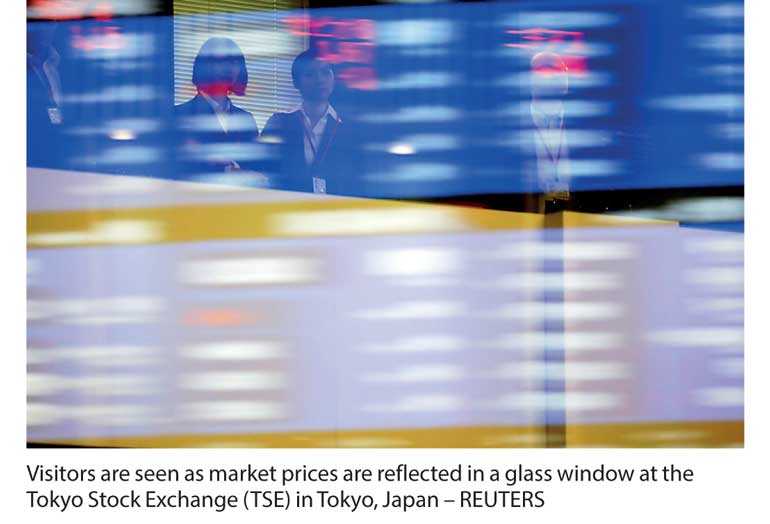Wednesday Feb 26, 2025
Wednesday Feb 26, 2025
Friday, 5 October 2018 00:00 - - {{hitsCtrl.values.hits}}
 LONDON (Reuters): A rise in US Treasury yields to their highest levels since mid-2011 pulled global bond yields higher across the board and boosted the dollar on Thursday, while stocks sagged in response.
LONDON (Reuters): A rise in US Treasury yields to their highest levels since mid-2011 pulled global bond yields higher across the board and boosted the dollar on Thursday, while stocks sagged in response.
An influential survey of the US services sector showed activity at its strongest since August 1997, sparking speculation that the payrolls report on Friday could also surprise.
Comments from Federal Reserve Chairman Jerome Powell that economic outlook was “remarkably positive” and that rates might rise above “neutral” also helped the yield on the US 10-year Treasury climb to 3.18% on Wednesday.
Yields extended those gains on Thursday, having spiked to 3.2325% overnight, posting their steepest daily increase since the shock outcome of the US Presidential election in November 2016. It last traded at 3.2135%.
“The market is pricing in an additional 0.47% of rate increases in 2019 (nearly two hikes) compared to the Fed’s median projection of 0.75% (three hikes),” wrote Minneapolis-based US Bank Wealth Management Director of Fixed Income Bill Merz.
“The difference in market versus Fed expectations must be reconciled via lower Fed expectations or the higher market expectations. We anticipate further upward pressure on bond yields, because the Fed is unlikely to waver materially from its near-term path.”
The rise in US yields helped lift yields across Asia and Europe in response, while shares in emerging markets slipped. Higher US yields are anything but favourable for emerging markets as they tend to draw away much-needed foreign funds while pressuring local currencies.
MSCI’s broadest index of Asia-Pacific shares outside Japan skidded 1.7%, with South Korea, the Philippines, Indonesia and Taiwan all down.
Even the Nikkei eased half a%, as rising yields offset the boost to exporters from a weaker yen.
EMini futures for the S&P 500 also lost 0.4% in European trade, while European stocks last traded down 0.7%.
Euro zone bond yields rose sharply, tracking their US counterpart, while the ‘trans-Atlantic spread’ between United States and German 10-year bond yields hit a three-decade high of around 275 bps.
Germany’s 10-year bond yield, the benchmark for the region, hit a 4-1/2 month high of 0.55% before settling at around 0.53%, still up six basis points on the day.
“If the Fed is to hike rates beyond the neutral level, the underlying case is that the economy is doing very well – and if the US economy is doing very well – that has spillover effects the euro zone,” said DZ Bank Analyst Rene Albrecht.
“This will make it easier for the ECB to raise rates in 2019; and you will see this impact yields in the euro zone, especially at the long end,” he added.
The exception of the day was Italy, where borrowing costs dropped for a second day, after the Government said it would cut budget deficit targets from 2020 and reduce its debt over the next three years.
Prime Minister Giuseppe Conte on Wednesday confirmed a deficit target of 2.4% of gross domestic product (GDP) in 2019 and said this would fall to 2.1% in 2020 and 1.8% in 2021.
The estimates for 2020 and 2021 were lower than those initially reported, bringing further relief to bond markets rattled by the new Government’s plans to ramp up spending.
Italy’s two-year bond yield was last down two basis points at 1.234%.
In currencies, the dollar gave up some of the gains that took it to a six-week high against a basket of peers, to stand up 0.1% on the day.
Oil prices slipped from four-year highs, pressured by rising US inventories and after sources said Russia and Saudi Arabia struck a private deal in September to raise crude output.
Brent eased 0.2% to $ 86.13 a barrel on Thursday, while US crude also fell 0.1% to $ 76.28 a barrel.
Gold prices moved in a narrow range, last trading up 0.3% at $ 1.200.52 per ounce.
Discover Kapruka, the leading online shopping platform in Sri Lanka, where you can conveniently send Gifts and Flowers to your loved ones for any event including Valentine ’s Day. Explore a wide range of popular Shopping Categories on Kapruka, including Toys, Groceries, Electronics, Birthday Cakes, Fruits, Chocolates, Flower Bouquets, Clothing, Watches, Lingerie, Gift Sets and Jewellery. Also if you’re interested in selling with Kapruka, Partner Central by Kapruka is the best solution to start with. Moreover, through Kapruka Global Shop, you can also enjoy the convenience of purchasing products from renowned platforms like Amazon and eBay and have them delivered to Sri Lanka.
Discover Kapruka, the leading online shopping platform in Sri Lanka, where you can conveniently send Gifts and Flowers to your loved ones for any event including Valentine ’s Day. Explore a wide range of popular Shopping Categories on Kapruka, including Toys, Groceries, Electronics, Birthday Cakes, Fruits, Chocolates, Flower Bouquets, Clothing, Watches, Lingerie, Gift Sets and Jewellery. Also if you’re interested in selling with Kapruka, Partner Central by Kapruka is the best solution to start with. Moreover, through Kapruka Global Shop, you can also enjoy the convenience of purchasing products from renowned platforms like Amazon and eBay and have them delivered to Sri Lanka.